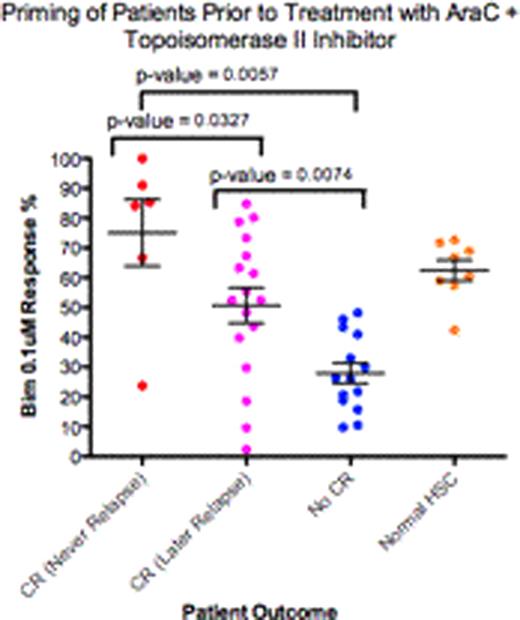Abstract
Abstract 239
The mechanistic basis for differential response to induction therapy in AML is poorly understood. Our laboratory has found that primary normal and malignant cells vary greatly in the proximity of their mitochondria to the threshold of apoptosis. This sensitivity is largely dictated by the BCL-2 family of proteins at the mitochondria. Cells that have greater sensitivity to apoptosis are referred to as being more “primed” for death.
Using a novel FACS-based assay called BH3 profiling, we can directly measure the degree of priming for individual cells within heterogeneous samples obtained from patients. BH3 profiling measures mitochondrial response to a panel of peptides composed of the BH3 domains of death-signaling proteins in the BCL-2 family. We studied the mitochondria of myeloblasts of more than 50 patients prior to their receiving induction or re-induction chemotherapy for AML. Gating for the AML blast population using CD45 and side scatter, we have found that patients with highly primed blasts are significantly more likely to achieve a complete remission (CR) than patients with low priming. Specifically, priming was found to predict killing by topoisomerase II inhibitors like etoposide, idarubicin, daunorubicin and mitoxantrone used during induction chemotherapy. Moreover, we measured the priming of normal human hematopoietic stem cells (HSCs) within the Lin−CD34+CD38−CD45RA−CD90+ gate. We found that HSC mitochondria have an intermediate level of priming that forms the boundary line between the priming of responsive versus refractory myeloblasts.
AML blasts from patients that achieve CR and never relapse (red) are more primed than AML blast from patients who don't achieve CR (blue). Patients that achieve CR but later relapse are also more primed than refractory patients. Normal HSCs (orange) are intermediately primed and may set the therapeutic window.
AML blasts from patients that achieve CR and never relapse (red) are more primed than AML blast from patients who don't achieve CR (blue). Patients that achieve CR but later relapse are also more primed than refractory patients. Normal HSCs (orange) are intermediately primed and may set the therapeutic window.
AML blasts, whether from patients that achieve CR or that don't achieve CR, are more responsive to ABT-737 than normal human HSCs. IC50 was determined after 9 hour culture of primary samples in the presence of various concentrations of ABT-737.
AML blasts, whether from patients that achieve CR or that don't achieve CR, are more responsive to ABT-737 than normal human HSCs. IC50 was determined after 9 hour culture of primary samples in the presence of various concentrations of ABT-737.
Letai:Eutropics Pharmaceuticals: Consultancy, Membership on an entity's Board of Directors or advisory committees.
Author notes
Asterisk with author names denotes non-ASH members.



